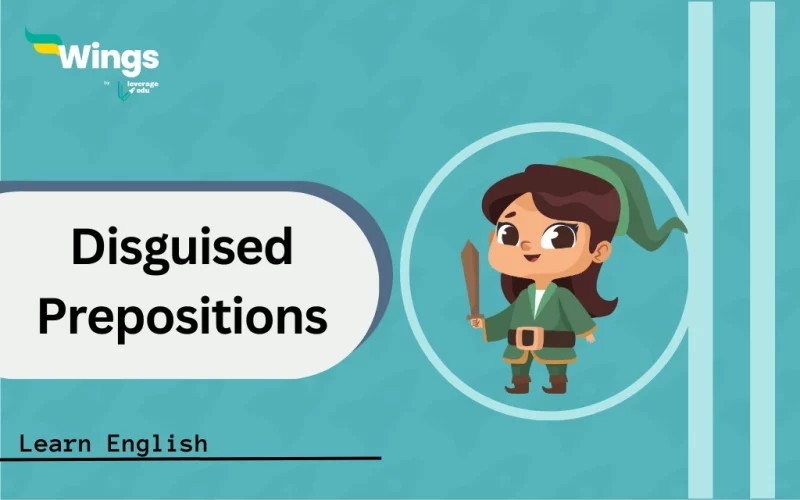A disguised preposition is a type of preposition that is not used or implemented directly in sentences. Some common examples of disguised prepositions are “a” and “o”. Disguised Preposition is used before any word to build a relationship with another word. The blog will help you to gain knowledge about these prepositions and clear all your doubts with the help of definitions, examples and more for easy learning.
This Blog Includes:
- What is a Disguised Preposition?
- How are Disguised Prepositions Formed?
- Examples of Two-Words Disguised Prepositions
- Examples of Three Words Disguised Prepositions
- Difference Between Disguised Preposition and Participle Preposition
- Examples of Disguised and Participle Prepositions
- Disguised Prepositions Exercises and Answers
- FAQs
What is a Disguised Preposition?
A disguised preposition is a word that is used before any word in a way that builds a relationship with another word in a sentence. In most cases, the disguised preposition is used as an abbreviated form of prepositional phrases. For example, She works once a week. (in a week).
Also Read: All You Need to Know About Nouns
How are Disguised Prepositions Formed?
Disguised Prepositions also referred to as phrasal verbs, are formed by combining a verb with a preposition or an adverb to form a new word/meaning. It may or may not be linked to direct individual words.

Also Read: Best Podcasts to Improve English
Examples of Two-Words Disguised Prepositions
Examples of two-word disguised prepositions are mentioned below:
| Shut off | Switch on |
| Fill up | Lay over |
| Drop off | Head down |
| Take off | Back off |
| Walk off | Switch off |
| Catch up | Go over |
Also Read: Preposition: Definition, Types, and More
Examples of Three Words Disguised Prepositions
Here are some of the three words disguised preposition:
| Count on for | Look forward for |
| Take advantages for | Get rid of |
| Put it up | Take it off |
| Get of me | Take care of |
| Stand up now | Take advantage of |
Also Read:25+ Active and Passive Voice Quiz [with Answers] for Practice
Difference Between Disguised Preposition and Participle Preposition
Disguised and participle prepositions are two different types of prepositions. The former is referred to as phrasal verbs, a combination of verbs, and prepositions; whereas, the latter is formed using a present participle form. Participle prepositions are also used to deliver additional information about an action or state of an object
Examples of Disguised and Participle Prepositions
Here are some examples listed below for your reference:
| Disguised Preposition | Participle Preposition |
| Shut off | Considering |
| Fill up | Exclusive |
| Drop off | Regarding |
| Take off | Including |
Disguised Prepositions Exercises and Answers
Circle the following with a suitable disguised preposition
- Can you look after the cat, as I’m going out?
- He decided to give up her job and start her own business.
- I accidentally bumped into an old friend in the mall yesterday.
- It’s time to turn off the lights and sleep.
- My friends had to call off the plans due to bad weather
- She needs to keep up on his studies if she wants to score well.
- We need to start the conference to discuss the new project.
- He always stands up for her sister when she’s in trouble.
- After a hectic day of work, I just need to unwind and relax.
- She decided to give up on her unhealthy habits and start doing yoga.
Answers
- Look after
- give up
- bumped into
- Turn off
- Call off
- Keep up
- Start the
- Stand up
- Unwind
- Give up
Related Posts to Read
FAQs
A disguised preposition is a type of preposition that is not used directly or implemented in the sentences, whereas mentioned directly. Examples of disguised prepositions are “a” and “o” respectively.
Below mention are the five prepositions:
Call off
Keep up
Start the
Stand up
Unwind
Simple prepositions represent a single word which expresses the relationship of time, direction, manner, or other relationship. They are commonly used as a type of preposition.
We hope this blog provided you with all the information about Disguised Preposition. To advance your grammar knowledge and read more informative blogs, check out our Learn English page and don’t forget to follow Leverage Edu.
 One app for all your study abroad needs
One app for all your study abroad needs














 45,000+ students realised their study abroad dream with us. Take the first step today.
45,000+ students realised their study abroad dream with us. Take the first step today.

